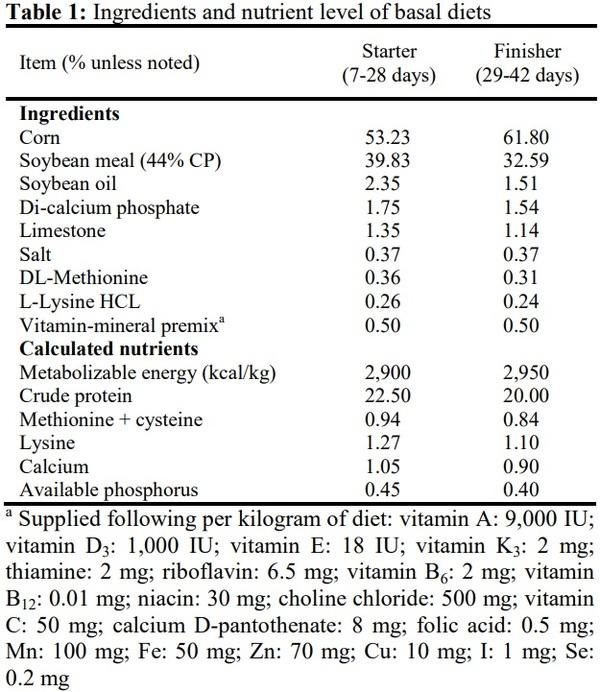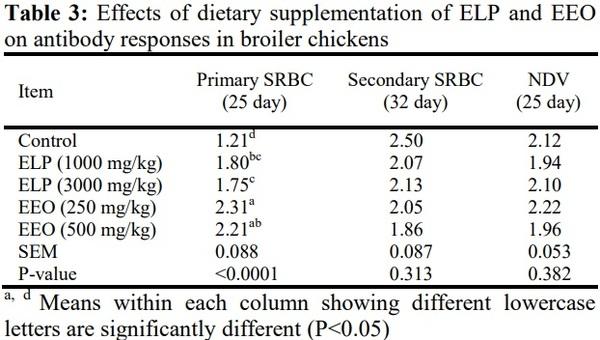Effects of using eucalyptus (Eucalyptus globulus L.) leaf powder and its essential oil on growth performance and immune response of broiler chickens



Amakura, Y; Umino, Y; Tsuji, S; Ito Hatano, T; Yoshida, T and Tonogai, Y (2002). Constituents and their antioxidative effects in eucalyptus leaf extract used as a natural food additive. Food Chem., 77: 47-56.
Barbour, EK; Bragg, RR; Karrouf, G; Iyer, A; Azhar, E;
Harakeh, S and Kumosani, T (2015). Control of eight predominant Eimeria spp. involved in economic coccidiosis of broiler chicken by a chemically characterized essential oil. J. Appl. Microbiol., 118: 583-591.
Barbour, EK; Saadé, MF; Abdel-Nour, AM; Kayali, G;
Kidess, S; Ghannam, RB; Harakeh, S and Shaib, H (2011). Evaluation of essential oils in the treatment of broilers co-infected with multiple respiratory etiologic agents. Int. J. Appl. Res. Vet. Med., 9: 317-323.
Barbour, EK; Yaghi, RH; Shaib, HA; Tayeb, IT and
Sleiman, FT (2008). Evaluation of an essential oil in treatment of immunosuppressed-coinfected broilers. Am.
Eurasian J. Sustain. Agric., 2: 212-218.
Danner, R; Chaudhari, SN; Rosenberger, J; Surls, J;
Richie, TL; Brumeanu, TD and Casares, S (2011).
Expression of HLA class II molecules in humanized
NOD.Rag1KO.IL2RgcKO mice is critical for development and function of human T and B cells. PLoS one. 6: e19826.
De Vincenzi, M; Mancini, E and Dessi, MR (1996).
Monographs on botanical flavouring substances used in foods. Part V. Fitoterapia. 67: 241-251.
Estanislau, AA; Barros, FAS; Peña, AP; Santos, SC; Ferri,
PH and Paula, JR (2001). Chemical composition and antibacterial activity of the essential oils of five species of eucalyptus grown in goiás. Braz. J. Pharmacog., 11: 95-
100.
Hassan, MSH; El Sanhoury, MH; Ali, WAH and Ahmed,
AMH (2011). Effect of using eucalyptus leaves as natural additives on productive, physiological, immunological and histological performance of laying Japanese quail. Egypt.
Poult. Sci., 31: 305-329.
King, DJ and Hopkins, SR (1983). Evaluation of the hemagglutination-inhibition test for measuring the response of chickens to avian infectious bronchitis virus vaccination.
Avian Dis., 27: 100-112.
Lee, KW; Everts, H; Kappert, HJ; Frehner, M; Losa, R and Beynen, AC (2003). Dietary carvacrol lowers body weight gain but improves feed conversion in female broiler chickens. J. Appl. Poult. Res., 12: 394-399.
Mansoori, B; Nodeh, H; Modirsanei, M; Kiaei, MM and
Farkhoy, M (2007). Evaluating the influence of tannic acid alone or with polyethylene glycol on the intestinal absorption capacity of broiler chickens, using d-xylose absorption test. Anim. Feed Sci. Technol., 134: 252-260.
Mesquita Júnior, D; Araújo, JAP; Catelan, TTT; de Souza,
AWS; de Melo Cruvinel, W; Andrade, LEC and da
Silva, NP (2010). Immune system-part II: basis of the immunological response mediated by T and B lymphocytes. Bras. J. Rheumatol., 50: 552-580.
Moore, BD; Foley, WJ; Wallis, IR; Cowling, A and
Handasyde, KA (2005). Eucalyptus foliar chemistry explains selective feeding by koalas. Biol. Lett., 1: 64-67.
Nyman, ME and Björck, IM (1989). In vivo effects of phytic acid and polyphenols on the bioavailability of polysaccharides and other nutrients. J. Food Sci., 54: 1332-
1335.
Ross (2007). Broiler nutrition specifications. Midlothian,
Scotland, UK, Aviagen.
Sadlon, AE and Lamson, DW (2010). Immune-modifying and antimicrobial effects of eucalyptus oil and simple inhalation. Altern. Med. Rev., 15: 33-47.
Salari, MH; Amine, G; Shirazi, MH; Hafezi, R and
Mohammadypour, M (2006). Antibacterial effects of
Eucalyptus globulus leaf extract on pathogenic bacteria isolated from specimens of patients with respiratory tract disorders. Clin. Microbiol. Infect., 12: 194-196.
SAS (1996). SAS/STAT User’s Guide. Version 6.12. SAS
Institute Inc., Cary, NC, USA.
Soyingbe, OS; Oyedeji, O; Basson, AK and Opoku, AR (2013). The essential oil of Eucalyptus grandis W. Hill ex
Maiden inhibits microbial growth by inducing membrane damage. Chinese Med., 4: 7-14.
Wallace, RJ; Oleszek, W; Franz, C; Hahn, I; Baser, KH;
Mathe, A and Teichmann, K (2010). Dietary plant bioactives for poultry health and productivity. Br. Poult.
Sci., 51: 461-487.
Wegmann, TG and Smithies, O (1966). A simple hemagglutination system requiring small amounts of red cells and antibodies. Transfusion. 6: 67-73.











.jpg&w=3840&q=75)